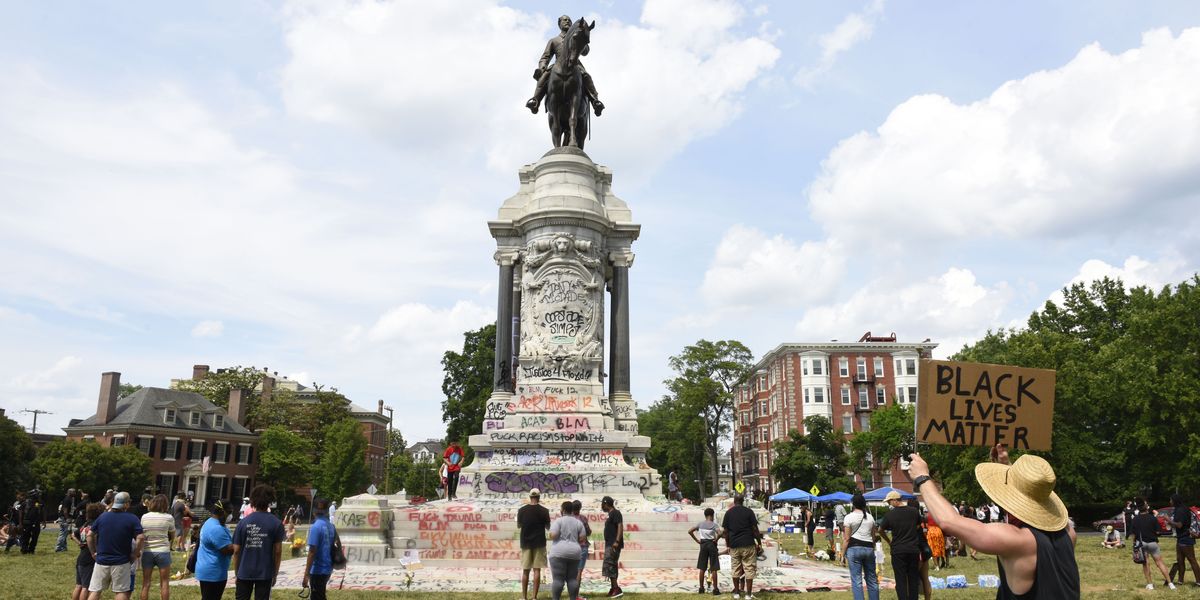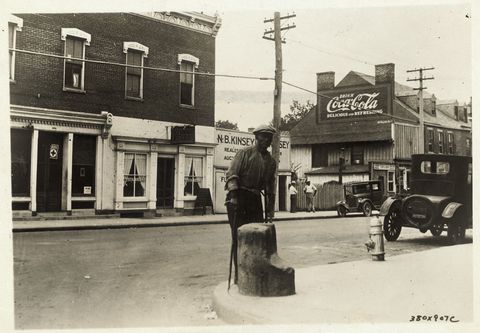Jefferson Davis, president of the Confederate States of America (1861-TBD) lies in the middle of the street, fully dressed and flat on his back, his hand outstretched to a nearby police officer in a futile entreaty for help. His metal finery is splattered with pink paint and his unfortunate state is illuminated by the blue lights of nearby cop cars. Minutes earlier, protestors descended upon him en masse and ripped him from the stone plinth in Richmond, Virginia on which he stood for nearly 113 years. It’s late at night on Wednesday June 10, 2020.
Hours before Davis came tumbling down to the cobblestone street, President Trump announced that he would resume his public rallies, beginning with a meeting in Tulsa, Oklahoma on Friday June 19, 2020. There are, at least, two things of note here: June 19 is the holiday known as Juneteenth, the day commemorating the arrival of Union troops in Galveston, Texas bearing the news of the Emancipation Proclamation, which had been signed two years earlier following Robert E. Lee’s surrender. In announcing the rally, White House Press Secretary Kayleigh McEnamy claimed, without evidence or much conviction, that Juneteenth was a day that was “meaningful” to the president.
Tulsa, Oklahoma, while possibly a strategically advantageous location for galvanizing Trump’s base is, more importantly, the site of a 99-year-old massacre of one of the nation’s most successful Black communities. Over the course of 24 hours, a white mob decimated the 300-plus Black-owned businesses, burning 35 square blocks, destroying 1,200 homes, and murdering an estimated 300 people. The Tulsa Massacre occurred on June 1, 1921.
It is possible that an event requiring as much advanced preparation and forethought as the president’s first mid-pandemic public rally in the middle of nationwide protests decrying violence against Black people could accidentally end up in Tulsa on Juneteenth. But if you believe that, I have a bridge to the Confederate States of America to sell you. Trump’s callousness, his calling card, is intentional. More importantly, it is indicative of the larger framework in which he, poor dead Jefferson Davis, and thousands of others thrive. Trump descends on Tulsa, ensconced on the plinth of white supremacy, a tourist in the American amusement park to Black trauma.
I use the word amusement intentionally. Think of the persistence of Confederate monuments and flags everywhere from, until this week, NASCAR to the Marines; think of the slave auction block in Fredericksburg, Virginia, a point of local interest that was removed last week after 176 years; think of the military bases named after Confederate generals that Trump defended today on Twitter. Or consider the supposedly benign: the plantation wedding, the elementary school named after Stonewall Jackson, the public park named after Robert E. Lee, the band Lady Antebellum. Imagine the thousands of other parts of American celebration, leisure, and luxury—the monuments, museums, movies, and merchandise—that all lead back to one source: a prolonged campaign of terror and violence meted out of Black bodies.
Lady Antebellum, now known as Lady A, is an interesting case. To their credit, they announced their name change today with a thoughtful message on social media. In it they wrote, “When we set out together almost 14 years ago, we named our band after the southern ‘antebellum’ style home where we took our first photos. As musicians, it reminded us of all the music born in the south that influenced us…Southern Rock, Blues, R&B, Gospel and of course Country. But we are regretful and embarrassed to say that we did not take into account the associations that weigh down this word referring to the period of history before The Civil War, which includes slavery.” Lady A did the right thing, but the freedom to not take into account the associations of their name is a luxury, a permanent vacation from an American reality.
For many, this may seem like a semantic distinction, a case where “intention versus impact” was taken too far. Some will call this an overreach of the PC police, as if Lady A was taken down to the station for questioning. Some will ask “How far will we go?” decrying the loss of history as if name changes and statue removals cause textbooks to spontaneously combust. For my part, I’m not interested in having yet another discussion about what people really mean when they celebrate or commemorate the Confederacy. I think the fact that we continue to have to have conversations about monuments and names and the like reinforces the point that for many Americans, a locus of historical trauma remains a source of entertainment, idyll interest, and leisurely consumption. The same is true for Indigenous Americans, who perpetually have to push back against our nation’s obsession with Christopher Columbus, in statues and street names, and also in those loci of leisure: parks and a national holiday. For those on vacation in the American reality, Columbus, and Stonewall Jackson and Robert E. Lee dot the landscape like waving costumed mascots. Rest stops selling flag merch become de facto gift shops. And Tulsa, the sight of unimaginable Black pain and death, is the backdrop for a stage show.
At this point in writing about the willful or benign American ignorance of Black trauma, it often feels necessary to put on a display of it. To, perhaps, prove the grievousness, the depth of it with personal narrative. To illustrate the insidious way that symbols of white supremacy ingratiate themselves into all of our consciousness and how damaging that can be. I want to resist that motivation because I do not want my own experience of trauma to become another attraction in the amusement park. It is crucial that when Black people express racial trauma—be it from symbols, overt action, microaggressions, or anything else—we don’t re-traumatize ourselves just to be believed or to enact change.
I understand the power of the personal to draw into sharp definition the abstract. I have seen in my own life how detailing the effect that the actions of others or the systems that we find ourselves in have affected me personally can change hearts and minds. I know that our stories can be learning tools. But I remain suspicious of placing the pedagogical use of pain over the cost to the individual. Suffice it to say, there are many instances where explaining the constant reminders of white supremacy, from stone statues to bumper stickers, from mastheads to the emails I get every time I write about my personal experience, leave me with nothing but the empty feeling of staring into a distorted mirror, lost in a funhouse in a dark corner of a decrepit amusement park that is still collecting admission.
So, instead, let’s return to Jefferson Davis, ass up in the street. I’d be lying if I said I didn’t enjoy the sight: the reaching hand like he’s waiting for a lil squirt of hand sanitizer; the splash of pink splotches like someone tossed a Pepto Bismol martini in his face; the way everyone around him just kind of ignores him. I’m tempted to say that this ruined figured is an attraction in my amusement park, but truth be told, it doesn’t amuse and if I’m going to use a vacation day, I’m certainly not going to spend it with the president of the Confederacy. But every time I see a Confederate monument ripped from its hinges, I do laugh, sometimes hollow and mirthless, but a laugh nonetheless. And the laughter, however empty, helps drown out the rage at the existence of the monument itself and at the thought of the current president stepping over the bones of the dead in Oklahoma, on a day commemorating a liberation that came two years overdue, to build a monument out of words to himself. Every time I see my people pull a statue from its perch, I laugh and for a moment there’s one less attraction in the museum
This content is created and maintained by a third party, and imported onto this page to help users provide their email addresses. You may be able to find more information about this and similar content at piano.io





